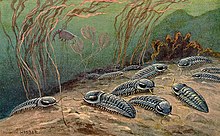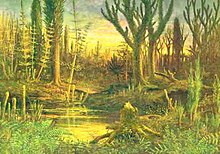Paleozoic
| Paleozoic | |||||||
|---|---|---|---|---|---|---|---|
| Chronology | |||||||
The Paleozoic ( Some geological timescales divide the Paleozoic informally into early and late sub-eras: the Early Paleozoic consisting of the Cambrian, Ordovician and Silurian; the Late Paleozoic consisting of the Devonian, Carboniferous and Permian.[3] The name Paleozoic was first used by Adam Sedgwick (1785–1873) in 1838[4] to describe the Cambrian and Ordovician periods. It was redefined by John Phillips (1800–1874) in 1840 to cover the Cambrian to Permian periods.[5] It is derived from the Greek palaiós (παλαιός, "old") and zōḗ (ζωή, "life") meaning "ancient life".[6] The Paleozoic was a time of dramatic geological, climatic, and evolutionary change. The Cambrian witnessed the most rapid and widespread diversification of life in Earth's history, known as the conifers ) appeared.
The Paleozoic Era ended with the largest Phanerozoic Eon,[a] the Permian–Triassic extinction event. The effects of this catastrophe were so devastating that it took life on land 30 million years into the Mesozoic Era to recover.[7]
Recovery of life in the sea may have been much faster.[8]
BoundariesThe base of the Paleozoic is one of the major divisions in geological time representing the divide between the Proterozoic and Phanerozoic eons, the Paleozoic and Neoproterozoic eras and the Ediacaran and Cambrian periods.[9] When Adam Sedgwick named the Paleozoic in 1835, he defined the base as the first appearance of complex life in the rock record as shown by the presence of trilobite-dominated fauna.[4] Since then evidence of complex life in older rock sequences has increased and by the second half of the 20th century, the first appearance of small shelly fauna (SSF), also known as early skeletal fossils, were considered markers for the base of the Paleozoic. However, whilst SSF are well preserved in carbonate sediments, the majority of Ediacaran to Cambrian rock sequences are composed of siliciclastic rocks where skeletal fossils are rarely preserved.[9] This led the International Commission on Stratigraphy (ICS) to use trace fossils as an indicator of complex life.[10] Unlike later in the fossil record, Cambrian trace fossils are preserved in a wide range of sediments and environments, which aids correlation between different sites around the world. Trace fossils reflect the complexity of the body plan of the organism that made them. Ediacaran trace fossils are simple, sub-horizontal feeding traces. As more complex organisms evolved, their more complex behaviour was reflected in greater diversity and complexity of the trace fossils they left behind.[9] After two decades of deliberation, the ICS chose Fortune Head, Burin Peninsula, Newfoundland as the basal Cambrian Global Stratotype Section and Point (GSSP) at the base of the Treptichnus pedum assemblage of trace fossils and immediately above the last occurrence of the Ediacaran problematica fossils Harlaniella podolica and Palaeopsacichnus.[10] The base of the Phanerozoic, Paleozoic and Cambrian is dated at 538.8+/-0.2 Ma and now lies below both the first appearance of trilobites and SSF.[9][10] The boundary between the Paleozoic and Mesozoic eras and the Permian and Triassic periods is marked by the first occurrence of the conodont Hindeodus parvus. This is the first biostratigraphic event found worldwide that is associated with the beginning of the recovery following the end-Permian mass extinctions and environmental changes. In non-marine strata, the equivalent level is marked by the disappearance of the Permian Dicynodon tetrapods.[11] This means events previously considered to mark the Permian-Triassic boundary, such as the eruption of the Siberian Traps flood basalts, the onset of greenhouse climate, ocean anoxia and acidification and the resulting mass extinction are now regarded as being of latest Permian in age.[11] The GSSP is near Meishan, Zhejiang Province, southern China. Radiometric dating of volcanic clay layers just above and below the boundary confine its age to a narrow range of 251.902+/-0.024 Ma.[11] GeologyThe beginning of the Paleozoic Era witnessed the breakup of the supercontinent of Pannotia[12][13] and ended while the supercontinent Pangaea was assembling.[14] The breakup of Pannotia began with the opening of the Iapetus Ocean and other Cambrian seas and coincided with a dramatic rise in sea level.[15] Cambrian Period The Cambrian spanned from 539–485 million years ago and is the first period of the Paleozoic Era of the Phanerozoic. The Cambrian marked a boom in evolution in an event known as the Cambrian explosion in which the largest number of creatures evolved in any single period of the history of the Earth. Creatures like algae evolved, but the most ubiquitous of that period were the armored arthropods, like trilobites. Almost all marine phyla evolved in this period. During this time, the supercontinent Pannotia begins to break up, most of which later became the supercontinent Gondwana.[16] Ordovician Period The Ordovician spanned from 485–444 million years ago. The Ordovician was a time in Earth's history in which many of the Ordovician–Silurian extinction events, in which 60% of marine invertebrates and 25% of families became extinct, and is considered the first Phanerozoic mass extinction event, and the second deadliest.[a][17]
Silurian PeriodThe Silurian spanned from 444–419 million years ago. The Silurian saw the rejuvenation of life as the Earth recovered from the previous glaciation. This period saw the mass evolution of fish, as jawless fish became more numerous, jawed fish evolved, and the first freshwater fish evolved, though arthropods, such as vascular plants (Cooksonia) allowed plants to gain a foothold on land. These early plants were the forerunners of all plant life on land. During this time, there were four continents: Gondwana (Africa, South America, Australia, Antarctica, Siberia), Laurentia (North America), Baltica (Northern Europe), and Avalonia (Western Europe). The recent rise in sea levels allowed many new species to thrive in water.[18]
Devonian PeriodEogyrinus (an amphibian) of the CarboniferousThe Devonian spanned from 419–359 million years ago. Also known as "The Age of the Fish", the Devonian featured a huge diversification of fish, including armored fish like Carboniferous PeriodThe Carboniferous spanned from 359–299 million years ago. During this time, average global temperatures were exceedingly high; the early Carboniferous averaged at about 20 degrees Celsius (but cooled to 10 °C during the Middle Carboniferous). Permian Period The Permian spanned from 299–252 million years ago and was the last period of the Paleozoic Era. At the beginning of this period, all continents joined together to form the supercontinent Pangaea, which was encircled by one ocean called synapsids flourished in the new dry climate. Creatures such as Dimetrodon and Edaphosaurus ruled the new continent. The first conifers evolved, and dominated the terrestrial landscape. Near the end of the Permian, however, Pangaea grew drier. The interior was desert, and new taxa such as Scutosaurus and Gorgonopsids filled it. Eventually they disappeared, along with 95% of all life on Earth, in a cataclysm known as "The Great Dying", the third and most severe Phanerozoic mass extinction.[a][22][23]
Climate  The early Cambrian climate was probably moderate at first, becoming warmer over the course of the Cambrian, as the second-greatest sustained sea level rise in the Phanerozoic got underway. However, as if to offset this trend, Gondwana moved south, so that, in Ordovician time, most of West Gondwana (Africa and South America) lay directly over the South Pole. The early Paleozoic climate was strongly zonal, with the result that the "climate", in an abstract sense, became warmer, but the living space of most organisms of the time – the continental shelf marine environment – became steadily colder. However, Over time, the warmer weather moved into the Paleozoic Era.The Ordovician and Silurian were warm greenhouse periods, with the highest sea levels of the Paleozoic (200 m above today's); the warm climate was interrupted only by a 30 million year cool period, the Early Palaeozoic Icehouse, culminating in the Hirnantian glaciation, 445 million years ago at the end of the Ordovician.[25]
The middle Paleozoic was a time of considerable stability. Sea levels had dropped coincident with the ice age, but slowly recovered over the course of the Silurian and Devonian. The slow merger of Baltica and Laurentia, and the northward movement of bits and pieces of Gondwana created numerous new regions of relatively warm, shallow sea floor. As plants took hold on the continental margins, metazoan life simply became hardier, or both. At any event, the far southern continental margins of Antarctica and West Gondwana became increasingly less barren. The Devonian ended with a series of turnover pulses which killed off much of middle Paleozoic vertebrate life, without noticeably reducing species diversity overall.
There are many unanswered questions about the late Paleozoic. The Mississippian (early Carboniferous Period) began with a spike in atmospheric oxygen, while carbon dioxide plummeted to new lows. This destabilized the climate and led to one, and perhaps two, ice ages during the Carboniferous. These were far more severe than the brief Late Ordovician ice age; but, this time, the effects on world biota were inconsequential. By the Cisuralian Epoch, both oxygen and carbon dioxide had recovered to more normal levels. On the other hand, the assembly of Pangaea created huge arid inland areas subject to temperature extremes. The Lopingian Epoch is associated with falling sea levels, increased carbon dioxide and general climatic deterioration, culminating in the devastation of the Permian extinction.
Flora While macroscopic plant life appeared early in the Paleozoic Era and possibly late in the Neoproterozoic Era of the earlier eon, plants mostly remained aquatic until the Silurian Period, about 420 million years ago, when they began to transition onto dry land. Terrestrial flora reached its climax in the Carboniferous, when towering Carboniferous Rainforest Collapse which fragmented this habitat, diminishing the diversity of plant life in the late Carboniferous and Permian periods.[26]
FaunaA noteworthy feature of Paleozoic life is the sudden appearance of nearly all of the invertebrate animal phyla in great abundance at the beginning of the Cambrian. The first vertebrates appeared in the form of primitive fish, which greatly diversified in the Silurian and Devonian Periods. The first animals to venture onto dry land were the arthropods. Some fish had lungs, and powerful bony fins that in the late Devonian, 367.5 million years ago, allowed them to crawl onto land. The bones in their fins eventually evolved into legs and they became the first tetrapods, 390 million years ago, and began to develop lungs. Amphibians were the dominant tetrapods until the mid-Carboniferous, when climate change greatly reduced their diversity. Later, reptiles prospered and continued to increase in number and variety by the late Permian period.[26] The Palaeozoic marine fauna was notably lacking in predators relative to the present day. Predators made up about 4% of the fauna in Palaeozoic assemblages while making up 17% of temperate Cenozoic assemblages and 31% of tropical ones. Infaunal animals made up 4% of soft substrate Palaeozoic communities but about 47% of Cenozoic communities. Additionally, the Palaeozoic had very few facultatively motile animals that could easily adjust to disturbance, with such creatures composing 1% of its assemblages in contrast to 50% in Cenozoic faunal assemblages. Non-motile animals untethered to the substrate, extremely rare in the Cenozoic, were abundant in the Palaeozoic.[27] MicrobiotaPalaeozoic phytoplankton overall were both nutrient-poor themselves and adapted to nutrient-poor environmental conditions. This phytoplankton nutrient poverty has been cited as an explanation for the Palaeozoic's relatively low biodiversity.[28] See also
FootnotesReferences
Further reading
External linksWikimedia Commons has media related to Paleozoic. Wikisource has original works on the topic: Paleozoic | |||||||
